Charon: The Ferryman of the Dead, (Boatman of the Lower Planes)
“Discover the chilling truth about Charon, the ghostly ferryman who holds the key to the afterlife!”
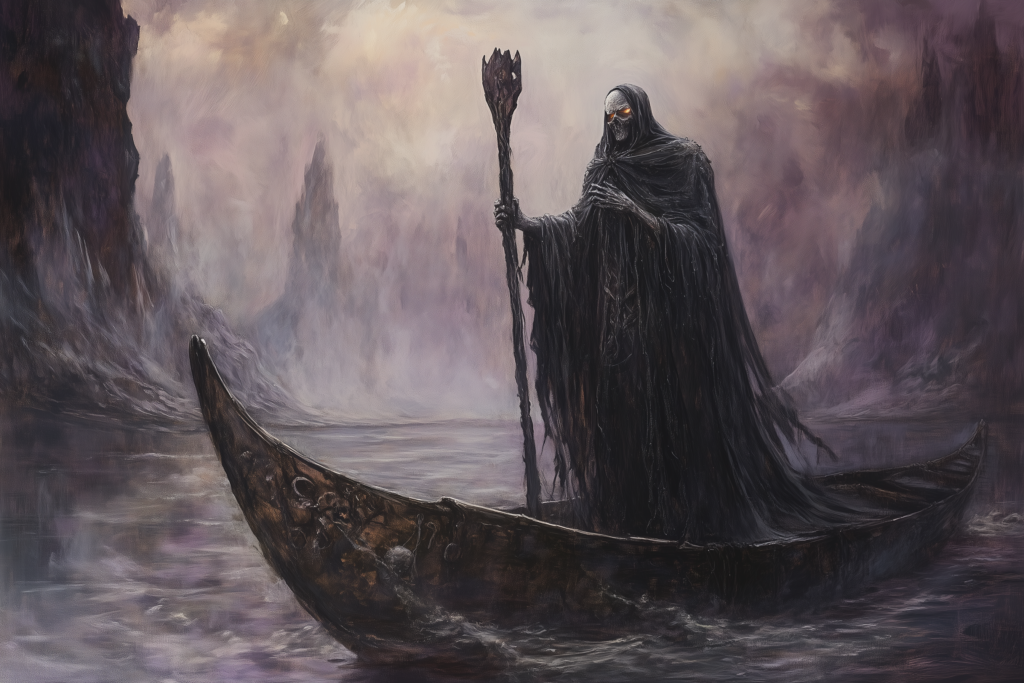
Charon, one of the most enigmatic figures in Greek mythology, stands as the eternal ferryman of the underworld. His job is not one of choice, but of duty—a duty to transport the souls of the deceased across the river Styx, the boundary between life and death. Throughout the ages, he has been both feared and misunderstood, a symbol of death’s inevitable passage. Yet, Charon’s life is marked by a unique blend of solemnity, power, and tragedy, for he alone holds dominion over the souls that journey through the afterlife.
Life Story and Events: Charon was the son of Nyx, the primordial goddess of the night, and Erebos, the god of darkness. His lineage ties him directly to the very forces of the universe that govern the realms of death and shadow. However, Charon was not born into fame or fortune—he inherited the somber task of ferrying souls for the gods of the underworld, primarily Hades.
The most significant event in Charon’s life is his appointment as the ferryman of the dead. Charon is tasked with guiding souls across the River Styx, but only those who can pay the toll—a coin placed in the mouth of the deceased to serve as payment for his service. Those who cannot afford the coin are condemned to wander the shores of the Styx for eternity, unable to enter the afterlife. This coin, known as the obolus or danake, is an essential element of Greek death rites, marking the separation between the living world and the underworld.
Charon’s exploits are largely centered around his ceaseless duty to ferry souls. He is often depicted as a dark, silent figure in a tattered cloak, rowing a boat across the murky waters of the Styx. While he does not engage with the souls directly, Charon’s actions are integral to the orderly passage of spirits into the afterlife, ensuring they reach Hades’ domain. The silence of his work reflects the cold finality of death itself—no words are exchanged, no negotiation or mercy is offered.
Although he remains a solitary figure in the mythological world, Charon’s brief but poignant involvement with mortals and gods alike has shaped his legend. In some versions of his myth, Charon is said to have crossed paths with the great Heracles. The hero, in his quest to retrieve Cerberus from the underworld, needed to cross the Styx, and Charon begrudgingly ferried him across. However, Charon is most famously associated with the deceased, and his role remains crucial in all myths involving the passage from life to death.
Character: Charon is a figure defined by his detachment. Stoic, emotionless, and grim, he has little to say or show—his role demands neither joy nor sorrow. In many ways, he is a mirror of the inevitability of death itself—unchanging, unfeeling, and eternal. His appearance is typically that of an old man, draped in a dark cloak, with a gnarled face partially obscured by shadow. His boat, a simple and unadorned vessel, is the only mode of transport for souls, adding to the simplicity and somberness of his work.
Despite his apparent coldness, Charon’s actions are motivated by duty rather than malice. His role is not one of choice, but rather a consequence of his divine heritage. He has no power to release souls from their fate, nor can he alter the course of death. His task is to perform his duties without question, devoid of any personal ambition or desire.
Fears and Motivations: While Charon may appear devoid of emotion, he is not without fear. His deepest fear is the eventual collapse of order in the afterlife. He lives in constant awareness that his role, and the very passage of the dead, is crucial to maintaining balance in the universe. Without him, the souls of the departed would remain stranded on the shores of the Styx, unable to pass on. The chaos that would ensue from this imbalance is something Charon dreads, for it would not only disrupt his work but unravel the very foundation of the afterlife.
Though Charon’s actions may seem heartless or indifferent, they stem from a profound sense of duty. He does not seek power or glory, but the preservation of order in the afterlife. He ferries the souls with a methodical precision, ensuring that no soul is left behind, no journey is interrupted. His work is not a choice, but an obligation—one that ties him eternally to the underworld and the rule of Hades.
Charon is driven by a singular goal: to fulfill his responsibility. He knows that no matter how many souls he transports, his work will never end. The passage of time has no meaning for him. His reward is not a change in his circumstances but the preservation of cosmic order. In this way, Charon represents the inevitability of death, a force that persists regardless of the wishes of gods or mortals alike.
Achievements: Charon’s greatest achievement lies in his unwavering commitment to the afterlife’s function. He has ensured, for countless millennia, that the souls of the dead reach their destination, fulfilling his role as the ultimate guide between the world of the living and the realm of the dead. His ability to remain unchanged, through the flux of time and the ever-changing world of gods and mortals, marks him as one of the most persistent and enduring figures in mythology.
Though he does not seek glory, Charon is central to the smooth operation of the universe. Without him, the dead would be stranded, and the natural order would crumble. In this sense, his work is not only vital; it is sacred. He has achieved the quiet dignity of being indispensable, ensuring that the afterlife remains a place of transition rather than chaos.
Conclusion: Charon is a figure whose very existence underscores the nature of death and the passage of time. Stoic, unyielding, and solemn, he fulfills a role that no other can—guiding souls to the underworld, ensuring that death’s domain remains intact. Though he may not have the ability to shape the fates of the departed, his work is the bedrock upon which the entire structure of the afterlife rests. And though he is a figure of silence and duty, his legacy speaks volumes about the inevitability and the necessity of the passage from life to death.
Charon 5e
Charon 3.5
Charon, Ferryman of the Dead
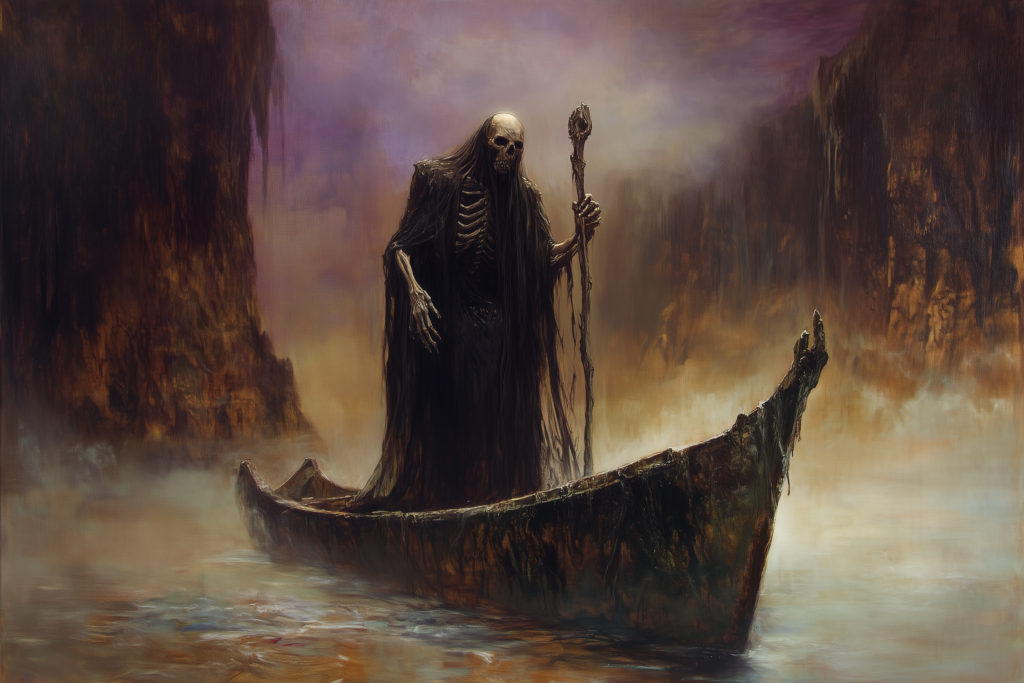
Large Celestial (Primordial), Neutral
Armor Class: 24 (Natural Armor)
Hit Points: 600 (40d10 + 200)
Speed: 30 ft., swim 60 ft., fly 30 ft. (hover)
| STR | DEX | CON | INT | WIS | CHA |
|---|---|---|---|---|---|
| 22 (+6) | 18 (+4) | 20 (+5) | 19 (+4) | 26 (+8) | 24 (+7) |
Saving Throws: Con +13, Wis +16, Cha +15
Skills: Insight +16, Perception +16, Intimidation +15
Damage Resistances: Necrotic, Psychic, Acid
Damage Immunities: Radiant, Cold, Fire, Nonmagical Bludgeoning, Piercing, and Slashing
Condition Immunities: Charmed, Frightened, Paralyzed, Exhaustion
Senses: Truesight 120 ft., Passive Perception 26
Languages: All, Telepathy 120 ft.
Challenge: 36 (290,000 XP)
Traits
Aura of Despair. Creatures of Charon’s choice within 60 feet that can see him must make a DC 23 Wisdom saving throw at the start of their turn or become frightened until the start of their next turn. If a creature succeeds, it is immune to this aura for 24 hours.
Soulbound Ferryman. Charon cannot be killed unless his oar, The Styxkeeper, is destroyed (AC 22, 200 HP, immune to nonmagical damage). If reduced to 0 hit points, Charon vanishes in a burst of shadow and reappears on the banks of the River Styx at full health in 1d10 days.
Master of the River. While Charon is within 300 feet of a large body of water (such as the Styx), he can use a bonus action to summon spectral oars to row his boat or to manipulate the water. Creatures that attempt to swim in or cross the Styx within 300 feet of Charon must succeed on a DC 23 Strength saving throw or be dragged 20 feet toward him by spectral hands.
Planar Navigator. Charon can move himself and any creatures or objects aboard his boat to any plane of existence, provided he is on the River Styx.
Actions
Multiattack. Charon makes three melee attacks or two attacks and uses a spell or his Oar of Souls.
The Styxkeeper (Oar). Melee Weapon Attack: +14 to hit, reach 10 ft., one target.
- Hit: 28 (4d10 + 6) bludgeoning damage plus 14 (4d6) necrotic damage. The target must succeed on a DC 23 Constitution saving throw or lose 1d4 hit points from their maximum, which can only be restored by a greater restoration spell or similar magic.
River’s Grasp (Recharge 5-6). Spectral hands rise from the waters of the Styx, targeting up to five creatures within 60 feet. Each creature must make a DC 23 Strength saving throw or be restrained for 1 minute. Restrained creatures take 21 (6d6) necrotic damage at the start of their turns. A creature can repeat the saving throw at the end of its turn, ending the effect on a success.
Soul Drain. Charon targets a creature within 30 feet that has been frightened, restrained, or incapacitated. The target must succeed on a DC 23 Charisma saving throw or take 44 (8d10) necrotic damage as part of its soul is pulled toward Charon. On a failure, the creature’s soul becomes fragmented, imposing disadvantage on all saving throws until the end of Charon’s next turn.
Boatman’s Toll. Charon demands a price for passage. Creatures within 60 feet must make a DC 23 Wisdom saving throw or lose 1d4 x 10 gold pieces (or equivalent valuables) from their possessions as spectral hands seize their wealth. If they cannot pay, they take 33 (6d10) necrotic damage instead.
Legendary Actions
Charon can take 3 legendary actions, choosing from the options below. Only one legendary action option can be used at a time, and only at the end of another creature’s turn.
- Stygian Smite. Charon makes one attack with The Styxkeeper.
- Ethereal Shift (Costs 2 Actions). Charon teleports to any unoccupied space within 60 feet, leaving behind a wisp of black mist.
- Summon Shades (Costs 3 Actions). Charon summons 3 shadows or 1 wraith to fight alongside him for 1 minute or until destroyed.
Spellcasting
Charon is a 20th-level spellcaster. His spellcasting ability is Wisdom (spell save DC 23, +15 to hit with spell attacks). He requires no material components to cast his spells.
At will: detect evil and good, thaumaturgy, toll the dead
3/day each: phantasmal killer, banishment, dimension door, counterspell
2/day each: circle of death, finger of death, wall of force
1/day each: plane shift, power word kill, time stop
Tactics
- Control and Fear: Charon uses Aura of Despair to spread fear among his enemies and River’s Grasp to restrain multiple foes, leaving them vulnerable to Soul Drain.
- Divide and Conquer: He isolates powerful enemies with wall of force and dispatches weaker foes using phantasmal killer or summoned shades.
- Terrifying Presence: Charon capitalizes on frightened enemies, draining their health and suppressing their defenses with his relentless attacks and abilities.
- Survivability: If cornered or in danger, Charon uses Ethereal Shift or time stop to reposition and regain control of the battlefield.
Charon is an implacable force of inevitability, combining devastating attacks, soul-draining powers, and battlefield control to maintain dominance in any encounter.
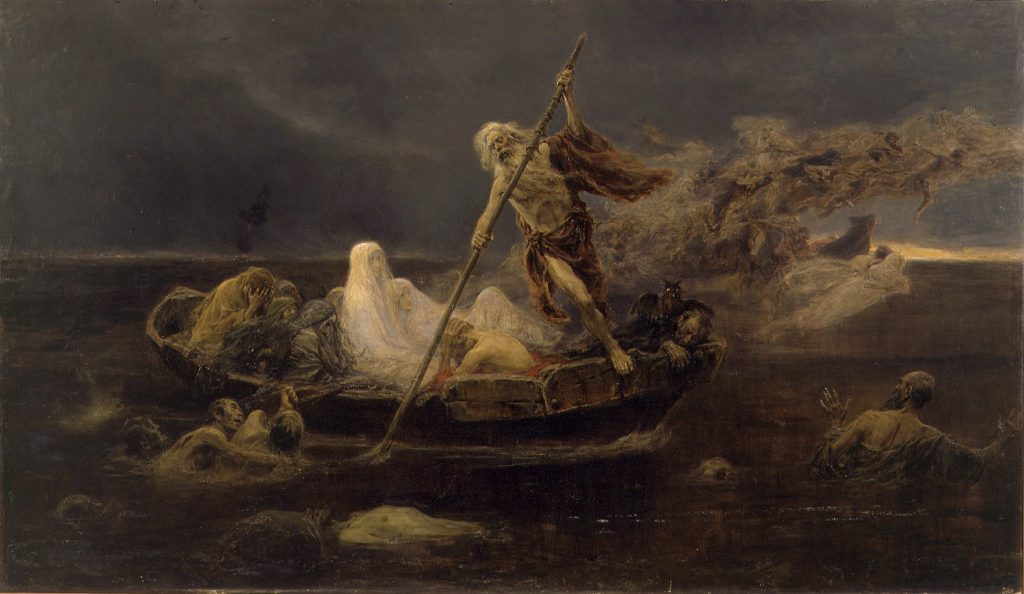
Charon is the ferryman of Hades.
He takes the newly dead from one side of the river Styx to the other if they had a coin to pay for the ride. Corpses are buried with a coin underneath their tongue to pay the fare. Those who can’t had to wander the banks of the Styx for a hundred years. The heroes Heracles, Orpheus, Aeneas, Dionysus and Psyche have all journeyed on the boat of Charon.
Charon is the son of Erebus and Nyx.
He was depicted as a cranky, skinny old man.
First appeared in the Monster Manual II (Gary Gygax, 1983) and converted by Scott Greene. In the book of Daemons
| Charon (Boatman of the Lower Planes) | |
| Medium-Size outsider (Evil) | |
| Hit Dice | 46d8+276 (483 hp) |
| Initiative | +9 (+5 Dexterity, +4 Improved Initiative) |
| Speed | 50 ft |
| AC | 38 (+5 Dexterity, +23 natural) |
| Attacks | Staff +55/+50/+45/+40/+35 melee |
| Damage | Staff 1d6+8 and Paralysis |
| Face/Reach | 5 ft by 5 ft/5 ft (10 ft with staff) |
| Special Attacks | Spell-like abilities, psionics, fear gaze, control water, summon daemons |
| Special Qualities | Damage reduction 40/+4, SR 34, daemon qualities, telepathy, immortality, Darkvision 60 ft |
| Saves | Fort +32, Ref +30, Will +32 |
| Abilities | Strength 26, Dexterity 21, Constitution 22, Intelligence 23, Wisdom 24, Charisma 28 |
| Skills | Bluff +58, Concentration +36, Diplomacy +39, Hide +25, Intimidate +44, Intuit Direction+56, Knowledge (arcana) +36, Knowledge (history) +36, Knowledge (planes) +55, Knowledge (religion) +36, Listen +56, Move Silently+45, Scry +31, Search +46, Sense Motive+56, Spellcraft +46, Spot +56 |
| Feats | Blind-Fight, Cleave, Dodge, Combat Expertise, Great Cleave, Improved Initiative, Improved Disarm, Improved Trip, Mobility, Power Attack, Sunder, Weapon Focus (staff) |
| Climate/Terrain | Any land (Lower Planes, River Styx only) |
| Organization | Solitary with Bone Skiff |
| Challenge Rating | 25 |
| Treasure | None |
| Alignment | Always neutral evil |
| Advancement | By character class |
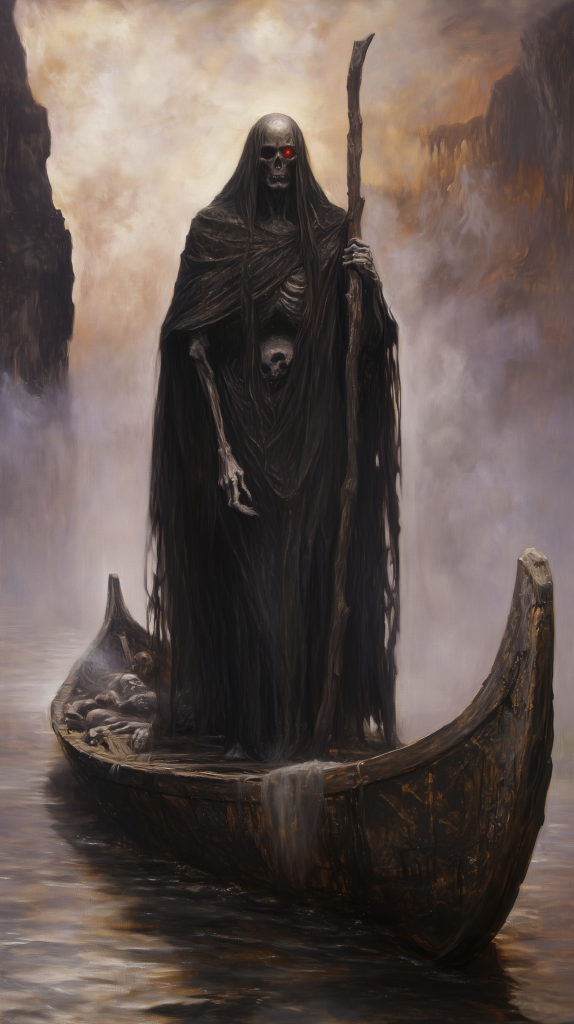
The river Styx links the topmost layers of the Lower Planes, and its branches can be found anywhere from the Nine Hells to the Abyss. When encountered, the river is a deep, swift, and uncontrolled torrent. Those who touch or drink from the river Styx must succeed at a Will save (DC 20) or completely lose their memory, forgetting everything about their past life. If the save is made, treat the effects as a feeblemind as cast by a 15th-level sorcerer.
Charon may be summoned to the banks of the Styx by casting any of the following spells: blasphemy, Holy word, or symbol of death, symbol of fear, symbol of insanity, symbol of pain, symbol of persuasion, symbol of strife, symbol of stunning, symbol of weakness.
He will appear in a large black skiff that can hold up to 10 people of Medium-size. If requested ferry, he will charge a magic item, a silk bag of 100 pp, or two gems of 500+ gp value. Charon never carries this treasure. It is distributed among his servants, the charonadaemons
Charon will not transport those who refuse or fail to pay his price.
Combat
Charon will attack using his spell-like abilities, gaze, and staff. If things are going against him he will summon charonadaemons or hydrodaemons to deal with the attackers, and teleport away, taking his boat with him.
Spell-Like Abilities: At will-alter self, charm person, contagion, invisibility, see invisible, silent image, and teleport without error (self plus boat only).
These abilities are as the spells cast by a 20th-level sorcerer (save DC 19 + spell level).
Psionics (Sp): At willdetect good, detect magic, and detect thoughts.
These are as the spells cast by a 20th-level sorcerer (save DC 19 + spell level).
Fear Gaze (Su): 30 feet range, Will save (DC 42) or flee in terror 2d6 rounds.
Paralysis: Anyone hit by Charon’s staff must succeed at a Fortitude save (DC 20) or be paralyzed for 3d6 minutes.
Control water (Su): As the spell cast by a 20th-level sorcerer. Charon may control the river Styx causing the water to rise up and attack as a 16 HD water elemental. Anyone hit by the elemental must make a Will save (DC 20) or forget everything about their past life. If the save is made, treat the effects as a feeblemind spell cast by a 15th-level sorcerer.
Immortality (Ex): Charon is native to all five Lower Planes, thus when his form is destroyed on one plane, he ceases to exist there, but still exists on the other four. When destroyed on any plane, it takes but a single day for his form to return.
Summon Daemons (Sp): Charon can automatically summon 2d6 charonadaemons or 2d6 hydrodaemons.
Daemon Qualities (Ex): Immune to poison and Paralysis, immune to mind-influencing effects; acid, cold, and fire resistance 40.
Telepathy (Su.): Daemons can communicate telepathically with any creature within 500 feet that has a language.
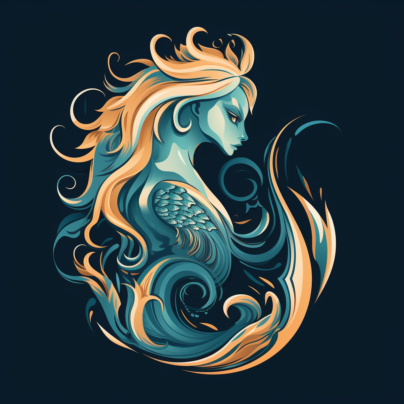
 Buy me a coffee
Buy me a coffee